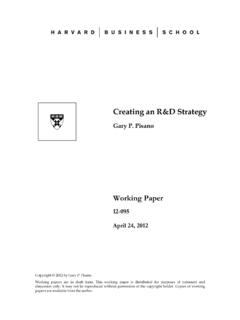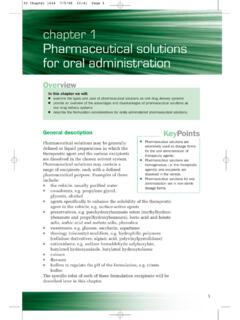Transcription of Glossary of Pharmaceutical Terms and Acronyms
1 Glossary of Pharmaceutical Terms and Acronyms This Glossary provides brief descriptions of selected Terms and concepts related to the Pharmaceutical industry. It is not intended to be a comprehensive list of relevant Terms or to provide a complete explanation of the included Terms and concepts. AAC: Actual Acquisition Cost. Usually a surveyed pharmacy drug acquisition cost. It is used by some state Medicaid agencies as a basis for reimbursement. aBLA: Abbreviated Biologics License Application. The pathway for FDA approval of biosimilar products. ADR: Adverse Drug Reaction. AMP: Average Manufacturer Price. A statutorily defined average price measure for drug products distributed to the retail class of trade that is used to determine Medicaid rebates and WAMP for generic drugs. It measures prices charged by manufacturers, net of discounts and rebates (excluding certain federal programs).
2 Although it is reported by manufacturers to CMS, it is not publicly available. ANDA: Abbreviated New Drug Application. The pathway for FDA approval that is generally used for generic drugs. See also NDA. API: Active Pharmaceutical Ingredient. Also referred to as Active Ingredient.. ASP: Average Sales Price. A statutorily defined price measure used to determine reimbursement for Medicare Part B covered drugs ( , physician-administered drugs). It measures average prices charged by manufacturers to all purchasers, net of discounts and rebates (excluding certain federal programs) and is reported by manufacturers to CMS. The payment limits derived from the ASPs are publicly available. At-Risk Launch: Typically refers to a situation where a manufacturer that is a defendant in a patent infringement lawsuit launches its product prior to full resolution of pending litigation.
3 Authorized Generic (AG): A brand name drug with an approved NDA that is marketed as a generic. AWP: Average Wholesale Price. A reference benchmark that may be used in determining the reimbursement amount for a drug. Batch: A specific quantity of material produced in a process such that it is expected to be homogenous within specified limits. Best Price: A statutorily defined measure of a minimum price for drug products distributed to the retail class of trade that is used to determine Medicaid rebates. It measures the lowest prices charged by manufacturers, net of discounts and rebates (excluding certain nominal transactions and federal programs). Although it is reported by manufacturers to CMS, it is not publicly available. Biologic: A drug product produced from or by biological (living) organisms. These products are often referred to as large molecule drugs because of the complexity of their chemical makeup.
4 Biosimilar: A biologic that is demonstrated to be similar to a reference biologic product. There is an abbreviated approval pathway for these products. See aBLA. These products may not be considered interchangeable with the reference biologic. BLA: Biologic License Application. The pathway for FDA approval of biologic drugs. See also aBLA. BPCIA: Biologics Price Competition and Innovation Act (2009). Created the abbreviated pathway for FDA approval of biosimilar products. See aBLA. Branded Product: A drug marketed under a brand name. Typically refers to products approved under an NDA or BLA/aBLA, though products approved under an ANDA may also be marketed with a brand name. CBER: Center for Biologics Evaluation and Research. CDER: Center for Drug Evaluation and Research. CGMP: Current Good Manufacturing Practices. FDA regulations that govern drug manufacturing processes.
5 Chargeback: Typically a payment made by a manufacturer to a wholesaler to reimburse the wholesaler for a discount that a manufacturer is contractually obligated to provide to the wholesaler's customer. Clinical Trial: Testing of an IND in human subjects. 2. CMS: Centers for Medicare and Medicaid Services. Compounding: Practice in which a pharmacist combines, mixes, or alters ingredients of a drug to create a medication. Contract Price: A negotiated price for a drug product. Coinsurance: A fixed percentage of the cost of a prescription drug at the point of sale that a pharmacy benefit plan requires the patient to pay. Copay Coupon: A voucher distributed to patients by the manufacturer of a drug that can be redeemed to cover at least some of the patients' out-of-pocket costs for the drug. Copayment: A flat payment amount required by a pharmacy benefit plan that the patient is responsible for paying at the pharmacy point of sale when obtaining a prescription.
6 These generally vary by formulary tier. CRO: Contract Research Organization. DAW: Dispense as Written. A notation by a prescriber that can dictate whether generic substitution will occur when a prescription is filled. Detailing: Efforts by sales representatives for drug manufacturers to educate prescribers about their products. Direct Contract: Contract between a drug manufacturer and a customer (such as a retail pharmacy) where the product does not pass through an intermediary wholesaler. Dispensing Fee: A contracted fee paid to a pharmacy for the service of dispensing/filling a prescription and advising patients. It does not include the drug cost, which is often referred to as the ingredient cost. Distributor: Similar to a wholesaler, but generally does not manage indirect contracts and chargebacks, or run source programs.
7 DTC: Direct to Consumer Advertising (also called DTCA). EAC: Estimated Acquisition Cost. Used in Medicaid statutes to refer to prices to be used in pharmacy reimbursement ( , the AAC or NADAC can be used by a state as its EAC). FDA: US Food and Drug Administration. Fill/Finish: Manufacturing step involving putting a drug into a container/delivery system under aseptic conditions. Formulary: A list of covered drugs provided by a pharmacy benefit plan describing the level of coverage for each product, and any limits, restrictions, or exclusions to that coverage. 3. FUL: Federal Upper Limit. A statutorily defined upper limit for Medicaid reimbursement of generic drugs. GDUFA: Generic Drug User Fee Amendments (2012/2017 updated GDUFA II). Generic Product: A drug marketed under its chemical name; generally refers to small molecule products approved by the FDA under an ANDA.
8 GLP: Good Laboratory Practices. GPO: Group Purchasing Organization. An entity that aggregates the purchases of health care providers ( , hospitals) and contracts with suppliers on their behalf to enable price discounts and efficiencies. Hatch-Waxman Act: Also known as the Drug Price Competition and Patent Term Restoration Act (1984). Among other provisions, created an abbreviated pathway for FDA. approval of generic drug products, statutory exclusivity provisions for new and patented drug products, and a 180-day exclusivity period for ANDA filers that challenge patents listed in the Orange Book. HCPCS: Healthcare Common Procedure Coding Sytem. A coding system used by CMS for Medicare to identify drugs and procedures for reimbursement. In this system, drugs are typically listed with a J or Q followed by a four-digit number.
9 IND: Investigational New Drug. Indirect Contract: Contract between a manufacturer and a customer (such as a retail pharmacy) where product passes through intermediary wholesaler. J-Code: Common term for Medicare HCPCS billing codes for Medicare Part B drugs. IRB: Institutional Review Board. Label: FDA-required labeling provided with medicines. Provides prescribing information such as approved indications, contra-indications, common side effects, and recommended dosing. Labeler: The entity that manufacturers, repacks, or distributes a drug product. See NDC. MAC: Maximum Allowable Cost. Upper limit set by an insurer (Medicaid or private plans) for the reimbursement of multiple-source generic drugs. MCO: Managed Care Organization. Medicaid: A state/federal system of health insurance for those requiring financial assistance.
10 Each state is responsible for its Medicaid program design, operation, and partial funding within federal guidelines managed by the CMS. Medicare Part A: Federal hospital insurance program for the elderly (qualifying age is generally 65). 4. Medicare Part B: A federal health insurance program for the elderly (qualifying age is generally 65). Covers non-hospital medical services and supplies, including injectable drugs delivered in an office setting. Medicare Part D: Optional additional Medicare coverage for prescription drugs. Covers the costs of medications not covered by Medicare Part B ( , oral medications obtained through a pharmacy). NADAC: National Average Drug Acquisition Cost. A surveyed pharmacy drug invoice cost provided by CMS for use in drug reimbursement by state Medicaid programs. NDA: New Drug Application.







